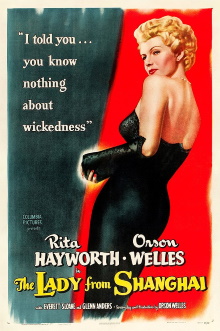Orson Welles is a very inconsistent director to say the least as he is known for plenty of stinkers along some of the most celebrated films of all that time. This noir was at the time of its release considered one of those stinkers but opinion on it has improved since then. I don’t think I like it very much given that it tries too hard to be clever rather than to be true to its theme. But it is a fascinating film that uses some inspired and beautiful camerawork so it probably is worth watching all the same.
Sailor Michael O’Hara is walking through a park when he sees the beautiful Elsa on a horse-drawn carriage. Later he rescues her when she is mugged and after escorting her back to the car park, learns that she previously lived in Shanghai and is now married to a famous criminal defense attorney Arthur Bannister. Being attracted to her, Michael tries to stay away but her husband comes looking for him to hire him to work on their yacht. During their cruise, they are joined by Bannister’s partner in the law firm, George Grisby. The cruise itself is ridiculous opulent as they go from port to port and Bannister delights in showing off how rich he is and Michael falls even more in love with Elsa. Yet Bannister knows that Michael is attracted to his wife and says that he is fine with it while also frequently deriding Grisby for being incompetent. Meanwhile Grisby, hearing that Michael once killed a man during his time in the Spanish Civil War, proposes that he commit a murder in exchange for a large sum of money, but what is even more intriguing is that the target of the murder he proposes is Grisby himself.
So this feels a lot like a Hitchcock film with Welles’ penchant for innovative shots. It seems that there were serious disagreements between Welles and the president of the studio at the time Harry Cohn with Cohn having the final say including ordering reshoots. This might explain some of the film’s idiosyncrasies. The on-location shots at places like Acapulco and even San Francisco’s Chinatown for example feel more authentic and beautiful but the courtroom scenes look like something that is more similar to other American films of the era with a lighter, more humorous tone. One of the most famous scenes in this film is the funhouse sequence which uses the crazy props and false perspective to illustrate Michael’s mental turmoil over the multiple betrayals and duplicities of the other characters. Welles intended this scene to go on for much longer so what we get here is only a truncated version. What this means is that this is a bit of a confused, mixed bag with even Welles himself not being convincing as an Irish sailor no matter how hard he tries with the accent.
The central theme of the film is spelled out for you in Michael’s story about the sharks, so no mystery there. I do like that Bannister, Elsa and Grisby each have schemes of their own but this film isn’t really trying to get you feel disgusted by their intrigue at all. It’s more about impressing you with Welles’ ability to think up a convoluted plot of nested betrayals. In any case, Bannister’s actions make no sense as he committed no crime and should have just reported everything to the police. It is interesting that the exoticism of Shanghai and China is used here as a shorthand for wickedness and sin. In particular at one point it looks like Michael is being rescued by Elsa’s Chinese servants but it soon turns out that they don’t have his best interests at heart. Of course that is seen as horribly racist today and their use of fake Chinese is just laughable. The real crime however is that the cultural reference is used so shallowly that it has no weight at all.
All in all, this is probably not a film worth going back for despite the presence of some cool shots. It might have been interesting if Welles had been allowed to make the film that he envisioned maybe but I have my doubts as he isn’t even being very convincing as an ordinary sailor here.
